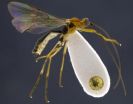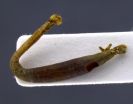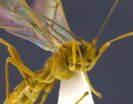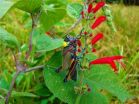(Press-News.org) Some Ecuadorian tribes were famous for making mummified shrunken heads from the remains of their conquered foes. Field work in the cloud forests of Ecuador by Professor Scott Shaw, University of Wyoming, Laramie, and colleagues, has resulted in the discovery of 24 new species of Aleiodes wasps that mummify caterpillars. The research by Eduardo Shimbori, Universidade Federal de São Carlos, Brazil, and Scott Shaw, was recently published in the open access journal ZooKeys.
Among the 24 new insect species described by Shimbori and Shaw, several were named after famous people including the comedians and television hosts Jimmy Fallon, John Stewart, Stephen Colbert, and Ellen DeGeneres, as well as the Ecuadorian artist Eduardo Kingman, American poet Robert Frost, and Colombian singer and musician, Shakira.
The Shakira wasp causes its host caterpillar to bend and twist in an unusual way, which reminded the authors of belly-dancing, for which the South American performer is also famous. In a previous work, Shaw had named a species after David Letterman.
"These wasps are very small organisms, being only 4 to 9 millimeters long, but they have an enormous impact on forest ecology," Shaw said. Aleiodes wasps are parasites of forest caterpillars. The female wasps search for a particular kind of caterpillar, and inject an egg into it. Parasitism by the wasp does not immediately kill the caterpillar, but it continues to feed and grow for a time. Eventually, feeding by the wasp larva causes the host caterpillar to shrink and mummify, then the immature wasp makes its cocoon inside the mummified remains of its conquered prey.
When it completes its development, the young wasp cuts an exit hole from the caterpillar mummy and flies away to mate, and continue this cycle of parasitic behavior. "Killing and mummifying caterpillars may sound bad, but these are actually highly beneficial insects," Shaw says. "These wasps are helping to naturally control the populations of plant-feeding caterpillars, so they help to sustain the biodiversity of tropical forests."
Shaw tells more about the behavior of parasitic wasps and other insects in his forthcoming book, Planet of the Bugs, due to be published by the University of Chicago Press in September.
The field research was conducted by Shaw at the Yanayacu cloud forest research station of Napo Province, in the eastern Andes slopes of Ecuador. Previous research by Shaw had discovered nine species of mummy-making wasps at the site, and others are known from around the world, but the full extent of these insect's biodiversity in Ecuador did not become apparent until recently, when Shimbori and Shaw collaborated to name them all. The research was supported by a grant from the National Science Foundation, called Caterpillars and Parasitoids of the Eastern Andes.
INFORMATION:
Original source:
Shimbori, E and Shaw, SR (2014) Twenty-four new species of Aleiodes Wesmael from the eastern Andes of Ecuador with associated biological information (Hymenoptera, Braconidae, Rogadinae). Zookeys 405: 1-81. doi: 10.3897/zookeys.405.7402
Additional information:
Shaw, SR (2014) Planet of the Bugs, Evolution and the Rise of Insects. University of Chicago Press, 256 pages. ISBN: 9780226163611. http://press.uchicago.edu/ucp/books/book/chicago/P/bo18507885.html
Mummy-making wasps discovered in Ecuador
New insect species named after Shakira and Jimmy Fallon
2014-05-08
ELSE PRESS RELEASES FROM THIS DATE:
NASA sees system 91B lingering over southwestern India
2014-05-08
The tropical low pressure area known as System 91B has been making a slow northerly crawl while sitting inland in southwestern India, and NASA's Terra satellite captured a visible image of the struggling storm that showed half of it is over the Northern Indian Ocean.
NASA's Terra satellite passed over System 91B over southwestern India and the Moderate Resolution Imaging Spectroradiometer (MODIS) instrument captured a visible image on May 8 at 05:40 UTC/1:40 a.m. EDT. The despite having a poorly defined low-level circulation center on infrared imagery, the circulation ...
Experimental antibody shows early promise for treatment of childhood tumor
2014-05-08
Tumors shrank or disappeared and disease progression was temporarily halted in 15 children with advanced neuroblastoma enrolled in a safety study of an experimental antibody produced at St. Jude Children's Research Hospital. Four patients are still alive after more than two-and-a-half years and without additional treatment.
Findings from the Phase I study were published recently online and will appear in the May 10 edition of the Journal of Clinical Oncology. The results prompted St. Jude to expand clinical trials of the monoclonal antibody hu14.18K322A to include patients ...
Wake Forest Baptist finds success with novel lung cancer treatment
2014-05-08
WINSTON-SALEM, N.C. – May 8, 2014 – An old idea of retreating lung tumors with radiation is new again, especially with the technological advances seen in radiation oncology over the last decade.
The Comprehensive Cancer Center of Wake Forest Baptist Medical Center is one of only a handful of cancer centers that is attempting to give lung cancer patients out of treatment options a chance to keep the cancer at bay. For these patients, hope lies in a second course of treatment – repeat radiation. Two complementary papers published back-to-back recently in the journal Radiotherapy ...
Health screening for low-income women under health care reform: Better or worse?
2014-05-08
New Rochelle, NY, May 8, 2014—When Massachusetts enacted its own statewide health insurance reform in 2006, low-income women transitioned from receiving free, federally subsidized screening for breast and cervical cancer and cardiovascular disease risk to an insurance-based payment system. The effects on screening rates in this vulnerable population are explored in Journal of Women's Health, a peer-reviewed publication from Mary Ann Liebert, Inc., publishers. The article is available free on the Journal of Women's Health website at http://online.liebertpub.com/doi/full/10.1089/jwh.2013.4612.
A ...
This FIB doesn't lie: New NIST microscope sees what others can't
2014-05-08
Microscopes don't exactly lie, but their limitations affect the truths they can tell. For example, scanning electron microscopes (SEMs) simply can't see materials that don't conduct electricity very well, and their high energies can actually damage some types of samples.
In an effort to extract a little more truth from the world of nanomaterials and nanostructures, researchers at the National Institute of Standards and Technology (NIST) have built the first low-energy focused ion beam (FIB) microscope that uses a lithium ion source.*
The team's new approach opens up ...
Oregon researchers capture handoff of tracked object between brain hemispheres
2014-05-08
EUGENE, Ore. -- When tracking a moving object, the two halves of the human brain operate much like runners successfully passing a baton during a relay race, says a University of Oregon researcher.
In a study online ahead of print in Current Biology, electroencephalogram (EEG) measured brainwaves from healthy young adults revealed how information about an attended object -- one being watched closely -- moves from one brain hemisphere to the other.
Such handoffs are necessary because the human visual system is contralateral; objects on the left side of space are processed ...
New grasshopper species named after Grammy winner
2014-05-08
A newly discovered grasshopper by University of Central Florida scientists now bears the name of Grammy-award winning singer and activist Ana Lila Downs Sanchez.
The scientists named the new species discovered on the side of a mountain road near Oaxaca, Mexico, after the Mexican-American singer as a nod to her efforts to preserve indigenous culture and penchant for wearing colorful, local costumes as part of her performances.
"It was primarily Paolo's idea to name the grasshopper after the singer" said Derek Woller, one of the authors of the paper referring to colleague ...
Obesity drug failing patients due to lack of education about side-effects
2014-05-08
A new study, published today in the Journal of Health Psychology, found that patients who gained weight 18 months after taking Orlistat attributed their weight-loss failure either to the side effects which have prevented them from sticking to the medication or felt that the medication simply had not worked.
The team from the University of Surrey also found that participants described a series of barriers to weight loss including psychological and physical health issues, relationships and the make-up of their bodies. They also described a number of alternative methods ...
Urine test best detects alcohol use in liver transplant candidates, recipients
2014-05-08
Researchers from Italy confirm that urinary ethyl glucuronide (uEtG) accurately detects alcohol consumption in liver transplant candidates and recipients. The study published in Liver Transplantation, a journal of the American Association for the Study of Liver Diseases and the International Liver Transplantation Society, suggests that a combination of uEtG and the Alcohol Use Disorders Identification Test for alcohol consumption (AUDIT-c) are best in alerting doctors to alcohol consumption by patients undergoing evaluation for liver transplantation or who have received ...
Breakthrough made at Max F. Perutz Laboratories
2014-05-08
Researchers at the Max F. Perutz Laboratories (MFPL) of the University of Vienna and the Medical University of Vienna made a breakthrough for the Platynereis model system, as they describe the first method for generating specific and inheritable mutations in the species. The method, in combination with other tools, now places this marine bristle worm in an excellent position to advance research at the frontiers of neurobiology, chronobiology, evolutionary developmental biology and marine biology. The study and a review on Platynereis dumerilii genetic methods were chosen ...
LAST 30 PRESS RELEASES:
Air pollution exposure and birth weight
Obstructive sleep apnea risk and mental health conditions among older adults
How talking slows eye movements behind the wheel
The Ceramic Society of Japan’s Oxoate Ceramics Research Association launches new international book project
Heart-brain connection: international study reveals the role of the vagus nerve in keeping the heart young
Researchers identify Rb1 as a predictive biomarker for a new therapeutic strategy in some breast cancers
Survey reveals ethical gaps slowing AI adoption in pediatric surgery
Stimulant ADHD medications work differently than thought
AI overestimates how smart people are, according to HSE economists
HSE researchers create genome-wide map of quadruplexes
Scientists boost cell "powerhouses" to burn more calories
Automatic label checking: The missing step in making reliable medical AI
Low daily alcohol intake linked to 50% heightened mouth cancer risk in India
American Meteorological Society announces Rick Spinrad as 2026 President-Elect
Biomass-based carbon capture spotlighted in newly released global climate webinar recording
Illuminating invisible nano pollutants: advanced bioimaging tracks the full journey of emerging nanoscale contaminants in living systems
How does age affect recovery from spinal cord injury?
Novel AI tool offers prognosis for patients with head and neck cancer
Fathers’ microplastic exposure tied to their children’s metabolic problems
Research validates laboratory model for studying high-grade serous ovarian cancer
SIR 2026 delivers transformative breakthroughs in minimally invasive medicine to improve patient care
Stem Cell Reports most downloaded papers of 2025 highlight the breadth and impact of stem cell research
Oxford-led study estimates NHS spends around 3% of its primary and secondary care budget on the health impacts of heat and cold in England
A researcher’s long quest leads to a smart composite breakthrough
Urban wild bees act as “microbial sensors” of city health.
New study finds where you live affects recovery after a hip fracture
Forecasting the impact of fully automated vehicle adoption on US road traffic injuries
Alcohol-related hospitalizations from 2016 to 2022
Semaglutide and hospitalizations in patients with obesity and established cardiovascular disease
Researchers ‘listen in’ to embryo-mother interactions during implantation using a culture system replicating the womb lining
[Press-News.org] Mummy-making wasps discovered in EcuadorNew insect species named after Shakira and Jimmy Fallon








